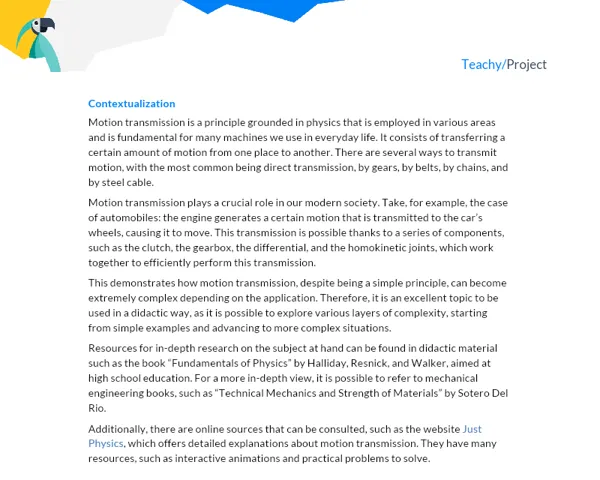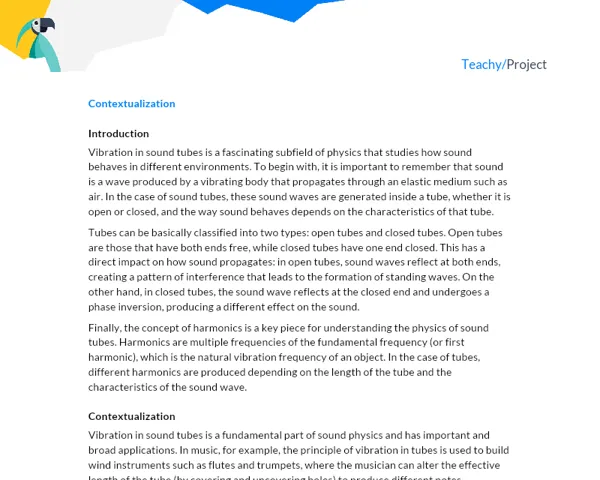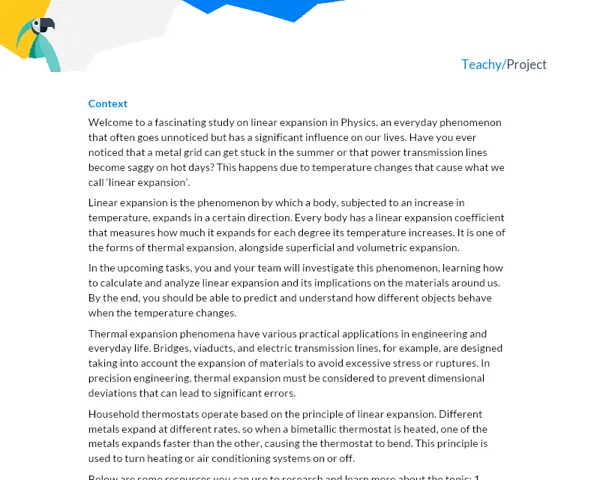Contextualization
Theoretical Introduction
Statics is the branch of Physics that studies bodies under the action of forces that balance each other, meaning the sum of forces and moments is zero. This state of a rigid body that does not accelerate, remaining at rest or in uniform linear motion, is known as equilibrium.
A fundamental concept for understanding Statics is that of Rigid Body. In summary, a rigid body is an object that does not deform under the action of external forces. In the study of Statics, we assume that all bodies are rigid, thus simplifying the analysis. This is a key concept that will be detailed in this project.
Another crucial point in statics is the Principle of the Lever. This principle reflects the idea that a force applied at a distance from the fixed point (pivot) of a rigid body can be balanced by a force of lesser intensity applied closer to the pivot. This is the basis of the operation of levers, pulleys, and gears, fundamental tools in machines and other structures in our daily lives.
Contextualization
Understanding Statics is not only relevant to physics, but it has implications in many areas of everyday life and various professions. Engineers, architects, and builders apply these principles to design and build stable structures such as bridges, buildings, and machinery.
Balance is also fundamental in the practice of physical activities. When lifting weights, for example, we need to consider balance and force distribution to avoid injuries. Even riding a bicycle requires understanding and unconsciously applying static concepts.
Understanding these concepts can empower us to make safer and more efficient decisions in our daily lives, as well as provide us with a better understanding of how the world works.
Practical Activity
Activity Title: "Build Your Own Torsion Balance"
Project Objective
Through the construction of a homemade torsion balance, students will explore the principles of statics of rigid bodies and develop a practical understanding of concepts such as equilibrium, moment of force, and levers. The knowledge gained in the project will empower students to understand, explore, and evaluate applications of Physics in everyday life.
Project Description
Groups will build a homemade torsion balance capable of measuring the weight of small objects (such as coins or small stones). After construction, they should use the balance to take measurements and compare the results with a conventional measuring instrument (such as a common balance).
Required Materials
- Wooden or metal bar about 40 cm long (can be a wooden square or a metal hanger).
- Fishing line or string.
- PET bottle or another object that can serve as a counterweight.
- Ruler or tape measure.
- Small objects of known weights (coins, stones, etc.).
- Common balance (for comparison).
- Pen and paper for notes.
Step by Step
- First, attach the fishing line to one end of the wooden bar so that it hangs horizontally. Ensure that the anchoring point of the line remains fixed. This will be the support point or pivot of the balance.
- Next, hang the PET bottle filled with water (or another object of considerable weight) on the other end of the bar. The weight of this object serves to create the necessary resistance to the torsion moment.
- Next, students should hang the objects of known weight at different points on the bar and record the resulting inclination. This directly follows from the principle of the lever and the notion of moment of force.
- Based on these records, students should be able to develop a weight scale for the balance, plotting a graph relating the distance of the object to the support point with the inclination of the bar.
- Finally, students should use this scale to try to determine the weight of an unknown object and compare their results with the measurements from a common balance.
Project Deliverables
After completing the practical activity, students should prepare a detailed report following the structure below:
1. Introduction
Include a contextualization of the project, its relevance and application in the real world as well as the objectives of this project. This may include an initial exploration of the principles of Statics of Rigid Bodies and the Principle of the Lever.
2. Development
In this section, students should detail the theory supporting the activity, including a detailed discussion on the equilibrium of a rigid body, the moment of force, and the principle of the lever. Next, describe the activity itself, the materials used, and the methodology followed. Finally, present and discuss the results obtained, comparing the measurements taken with the torsion balance with the measurements from a conventional balance.
3. Conclusion
Here, students should summarize the main points of their work, discuss what they learned throughout the project, and draw conclusions about the experience as a whole.
4. Bibliography
Finally, students should list the sources of information used during the project. This includes, but is not limited to, books, websites, videos, etc.
The project duration is one week. And the group size should be 3 to 5 students.



